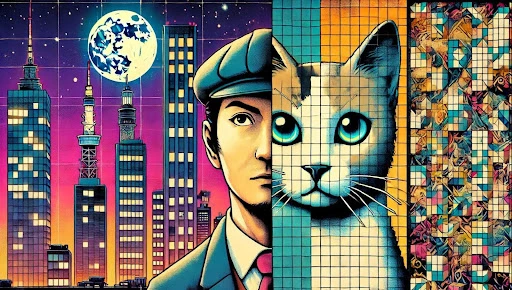
In 1987, the world witnessed a curious coincidence: two brilliant minds, without knowing each other, independently devised the same game mechanics that would give rise to one of the most popular pastimes on the planet: nonograms.
On one hand, Non Ishida, a Japanese graphic designer, had the brilliant idea of using the lights on and off of skyscrapers to create images visible from afar. This project was so innovative that it won a design contest held in Tokyo.
Almost simultaneously, Tetsuya Nishio, a renowned puzzle creator, was developing a logic game based on grids, numerical clues, and cells that had to be filled or left empty following these clues. The coincidence was not minor: both concepts shared an identical logical basis.
After their respective inventions, Nishio and Ishida published their puzzles in different magazines. Nishio did so in the well-known magazine Puzzler, while Ishida chose the Social Newspaper. Both formats quickly captured readers' attention, and the nonogram began to spread as a novel and stimulating entertainment.
In Japan, this new form of puzzle became known as Oekaki Logic, and in the UK, it was The Sunday Telegraph who, by publishing it for the first time in English, gave it the name that would transcend borders: Nonogram.
The 90s marked a crucial milestone in the international expansion of nonograms. In 1993, the publisher Sekai Bunkasha released the first volume of the book Oekaki Logic, which exceeded 200,000 copies sold in Japan.
But it was in 1995, with the arrival of Mario's Picross for Game Boy, when nonograms consolidated as a global phenomenon. Published by Nintendo, the Picross game adapted the puzzle mechanics to an interactive format, allowing millions of people worldwide to discover the excitement of solving hidden illustrations using only logic.
One of the most unique curiosities of nonograms is the incredible number of names by which they are known, depending on the country, publisher, or platform. Here are just a few:
Binary Coloring Books, Crucipixel, Edel, FigurePic, Griddlers, Hanjie, HeroGlyphix, Illust-Logic, Japanese Crosswords, Kare Karala, Logic Art, Logic Square, Logicolor, Logik-Puzzles, Logimage, Oekaki Logic, Oekaki-Mate, Paint by Numbers, Paint by Sudoku, Paint Logic, Pic-a-Pix, Picma, Picross, Picture Logic, Pixel Puzzles, Pintar por Números, PrismaPixels, Tsunamii...
Nonograms is undoubtedly one of the puzzles with the most aliases on the planet.
A nonogram is presented as a two-dimensional grid, where rows and columns include numerical clues. These clues indicate how many consecutive cells should be filled in that specific line. The player, through logical deduction, must determine which squares to color and which to leave blank to reveal, in the end, a hidden image.
This mechanism mixes mathematical logic with visual art, making it ideal for people who enjoy mental challenges and creative activities at the same time.
With the arrival of smartphones and tablets, nonograms have experienced a second golden age. Today, there are thousands of mobile applications for solving nonograms, from basic titles to advanced games with animated images, relaxing music, and daily challenges.
Platforms like Android and iOS host dozens of outstanding apps that add up to millions of downloads. Some of the most popular include:
Additionally, online versions of nonograms can also be found on specialized websites, where users can solve free puzzles, compete in global rankings, or even create and share their own custom challenges.
Beyond entertainment, nonograms have also proven to have a positive impact on cognitive development. Several studies suggest that their frequent practice can improve skills such as:
For these reasons, some teachers have incorporated them into school activities as a fun and effective way to stimulate logical reasoning in children and adolescents.
Today, there are international tournaments dedicated exclusively to nonograms. One of the most prestigious is organized by the World Puzzle Federation, where representatives from different countries participate showing their logical skills.
Likewise, forums, Facebook groups, Discord channels, and subreddits bring together thousands of enthusiasts who share strategies, templates, and unpublished puzzles.
Almost four decades later, the legacy of Tetsuya Nishio and Non Ishida continues to captivate millions of people. Their pioneering vision gave rise to a puzzle that has known how to reinvent itself with each new technology, without ever losing its essence: solving a hidden image with logic, cell by cell.
From illuminated skyscrapers to video games and mobile applications, the history of nonograms is a testimony of how a simple idea can transcend cultures and generations.